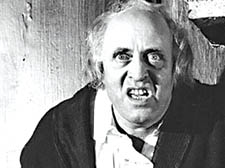|
|
 |
| |

Alistair Sim as Ebenezer Scrooge |
The father of modern Christmas
On Sunday, the New Journal’s charity screening of Scrooge at the new Belsize Park Everyman is introduced by Les Standiford whose new book tells the story of how Dickens, against all odds, revived the tradition of Christmas. Dan Carrier hears how he came to write it
IT has become a byword for the season, as much part of the lexicon of festivities as Father Christmas, holly, turkey and crackers. But A Christmas Carol, the Charles Dickens classic that brought us Ebenezer Scrooge, Jacob Marley, Bob Cratchit and Tiny Tim, was bashed out in just six weeks and self-published after the Victorian author was told by his editors it would be a flop.
On Sunday, Dickens expert, academic and author Les Standiford presents the New Journal’s charity screening of the classic 1951 film version of the book – Scrooge, starring Alistair Sim – at the newly opened Belsize Park Everyman.
Les’s recently published book, The Man Who Invented Christmas: How Charles Dickens’s A Christmas Carol Rescued His Career and Revived Our Holiday Spirits, reveals the little-known story behind how A Christmas Carol came to be – and how it almost didn’t make it out of Dickens’s imagination onto paper.
“It was published on December 19, 1843, and while initially rejected by Dickens’s long-time publishers Chapman & Hall, it became an instant bestseller, its initial print run of 6,000 snapped up before Christmas,” says Les.
“It went on to become the best-selling Christmas story of modern times and was said early in the 20th century to be second in readership only to the Bible in the English-speaking world. To date, some 250 film and video adaptations have been produced – the most accomplished of which is generally believed to be the 1951 version, starring Sim.”
“While Dickens had many triumphs and while every one of his 20 novels remains in print, as they have from the beginning, the slender story of A Christmas Carol has had the greatest lasting impact of all his works.”
Les’s idea for a book came about when he received a spam email with the tag line “Do You Realise....?” “The message asked if I knew that A Christmas Carol had been rejected by Dickens’s publishers, and that further, was I aware that facing bankruptcy, he had nonetheless bankrolled the publication of the book himself,” recalls Les.
“When I realised that no book had ever been written that discussed the impact of the book on both Dickens’s career and the downtrodden state of Christmas at the time, I decided it was a story that simply begged to be told.”
Dickens had approached his publishers with the idea of a ghost story in mid-October when he was at a very low ebb – but he hadn’t committed any words to paper. Things had not been going right for him for some time – he’d brought out books that had not been well received.
“I had no idea of the problems he was faced with, nor, I suspect, do most readers,” says Les.
“The general conception is that a writer of Dickens’s stature, once established, must have always had an easy time of it. Yet even after the tremendous success of such works at The Old Curiosity Shop, selling 100,000 copies at a crack, he found himself in a slough of despondency, his critical and popular reputation shot as a result of a couple of ill-advised books. Indeed, it does seem incredible that he pulled it all off.
“As many letters sent to friends and associates attest, he worked like a demon to finish the writing, and meantime had to arrange for printing, binding, design, illustrations and publicity,” says Les. “But he was resolute because he believed the book would change his career and change the world. And the amazing thing is, it did both.”
And Les believes that even though written and published in a hectic six weeks, Dickens lay the ground for ideas of Christmas that have resonated ever since.
“Dickens, while no friend of organised religion or politics,” says Les, “was resolute in his conviction that the essential message of Christmas was one of the celebration of the family and of life-force and of charity. He was resolute in his belief that right-minded individuals could by sheer dint of will and effort make a difference in eradicating poverty and ignorance, the twin banes of civilisation as he reckoned.
“For him ‘yes we can’ was no dream and no political slogan, but a simple statement of fact. Contemporary readers are captivated by the story and the modernity of the writing but they also understand that the message underlying A Christmas Carol is as significant and urgent today as it was during England’s ‘Hungry Forties’ when, the Sim version was conceived.”
|

|
 |
|
 |
|

